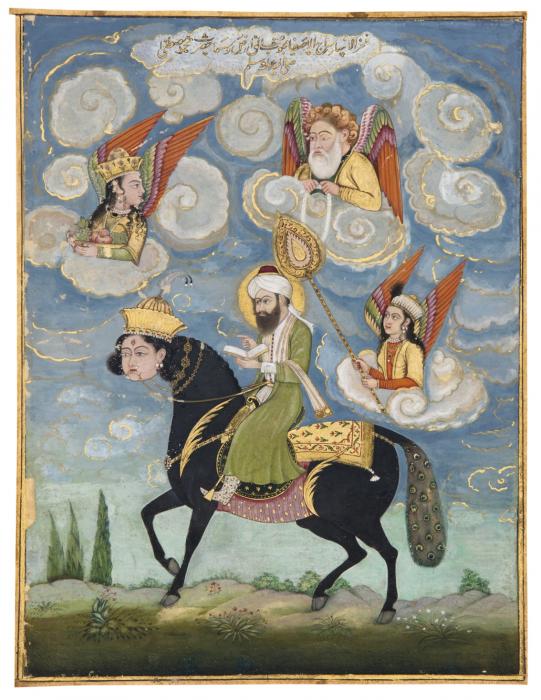Review: ‘Ilm: Art and Knowledge in Islam
Within Arabic, ‘Ilm is usually translated as ‘knowledge’. It also encompasses a wider set of ideas, such as the development of understanding, the application of wisdom and critical assessment of knowledge. ‘Ilm is also a word for ‘science’, so an understanding of ‘ilm is essential to the history of science, religion and philosophy for Arabic speaking cultures, and benefits Islamic studies as a whole. According to a hadith, or statement attributed to the Prophet Muhammad by Al-Tirmidhi, ‘the seeking of knowledge is obligatory for every Muslim’.
The ‘Ilm: Art and Knowledge in Islam exhibition at the Art Gallery of South Australia was curated by James Bennett to coincide with the international conference of the same name at the Centre for Asian and Middle Eastern Architecture (CAMEA) in the University of Adelaide. It occupies Australia’s only public gallery dedicated to historic Islamic art. The term ‘Islamic art’ usually refers to historic works by anonymous artisans, either Muslim or working for Islamic clients, which featured qualities that could be regarded as ‘Islamic’. The most overt of these include calligraphy, geometric abstraction, and abundant ornament upon functional items. This exhibition acknowledges and critiques these assumptions through carefully considered examples.
Upon entry, the viewer is immersed in sumptuous Ottoman tiles, layering the artworks against intricate and colourful tessellations. The scale of the room and presence of a magnificent Turkish fireplace evokes the home of a committed and well-travelled collector. The artworks emerge to reveal a wide range of forms in Islamic design – from the architectural to the wearable, from manuscripts to metal, with three walls dedicated to textiles, ceramics, and works on paper respectively. Figurative images and portraiture fill half the display, challenging the concept of Islamic art as primarily geometric abstraction or calligraphy. Many of these objects were designed with secular intent, challenging our need to unify them under the reductive term ‘Islamic’.
One could argue that a checklist item for major Islamic art galleries is a spectacular ceramic mihrab, a niche that indicates the orientation of Mecca. In ‘Ilm the hypothetical mihrab is replaced by the much more relatable fireplace. The Kutahya fireplace is a persistent feature in this room due to its weight and complexity of installation, along with the marble Jali screen, but its extravagance arguably reveals more about the imperatives of Ottoman visual culture than a religious object designed exclusively for prayer. These imperatives can be seen echoed in the William Morris rooms located nearby, where they are appreciated, translated and transformed by new localised contexts.
One of the most remarkable items is an 18th century Lucknowi depiction of the Prophet Muhammad riding his legendary steed Buraq. Given widespread misconceptions regarding the portrayal of Muhammad, this important object reminds us of the diversity of ways in which this figure has been portrayed by artists throughout history. It is echoed by the appearance of a Christian crucifixion scene on a ceramic tile. Like many other works in this exhibition, they provide a manifestation of changing, and sometimes unexpected, attitudes within Islamic visual cultures.
Details of acquisition are also significant—the Iranian ceramic tiles in ‘Ilm are amongst the very first Islamic artworks featured by an Australian public collection. These were acquired by the Art Gallery of South Australia precisely one hundred years ago through the bequest of Samuel Way. The ongoing generosity of Australian patrons of Islamic art is demonstrated through contributions from Barrie and Judith Heaven, William Bowmore and Michael Abbott QC. One unusual loan is the 99 Names (2010) by Mohammed Dendon, a master of the Tentmakers of Cairo. This is a khayamiya panel sewn with elaborate calligraphic applique in cotton on canvas, citing each of the ninety-nine divine attributes of Allah (Al-Amsa Ul-Husna). Dendon began sewing this panel shortly after being diagnosed with a serious illness, in accordance with the belief that a person who knows each of the ‘99 Names’ will be admitted to Paradise. It summarises ‘ilm as knowledge of a craft, a sense of personal purpose, and a broader cultural context. Given the weight of anonymity upon Islamic art history, this new object highlights the potential emergence of personal narratives. Displayed alongside Indian tent textiles with inlaid metallic threads and meticulous embroidery, it also evokes the diverse architectural heritage of tent design.
The most important contribution of this exhibition is not the interpretation of ‘ilm, nor any particular sequence of never-before-seen objects. It is the demonstration that historic Islamic art can, and should, feature in Australian public galleries on at least a modest scale. It is wonderful to see ambitious landmark exhibitions like Crescent Moon: Islamic Art and Civilisation of Southeast Asia (AGSA and NGA 2005), The Arts of Islam: Masterpieces from the Khalili Collection (AGNSW 2007), Beneath the Winds: Masterpieces of Southeast Asian art from the Art Gallery of South Australia (2011), Realms of Wonder: Jain, Hindu and Islamic art of India (AGSA 2013). Treasure Ships: Art in the Age of Spices (AGWA; AGSA 2014) and the current exhibition Beyond Words (AGNSW 2016-2017) here in Australia, but displays of Islamic art should not be saved for special events. This is a vast and topical field that has shaped global art histories and contemporary public discourse. The Art Gallery of South Australia’s ‘Islamic’ objects are not the most valuable or rare things within their extensive collection, but they are displayed with commitment to their potential as cultural bridges. We need to normalise the display of historic Islamic art in Australia, and ‘Ilm demonstrates how this might be achieved.


